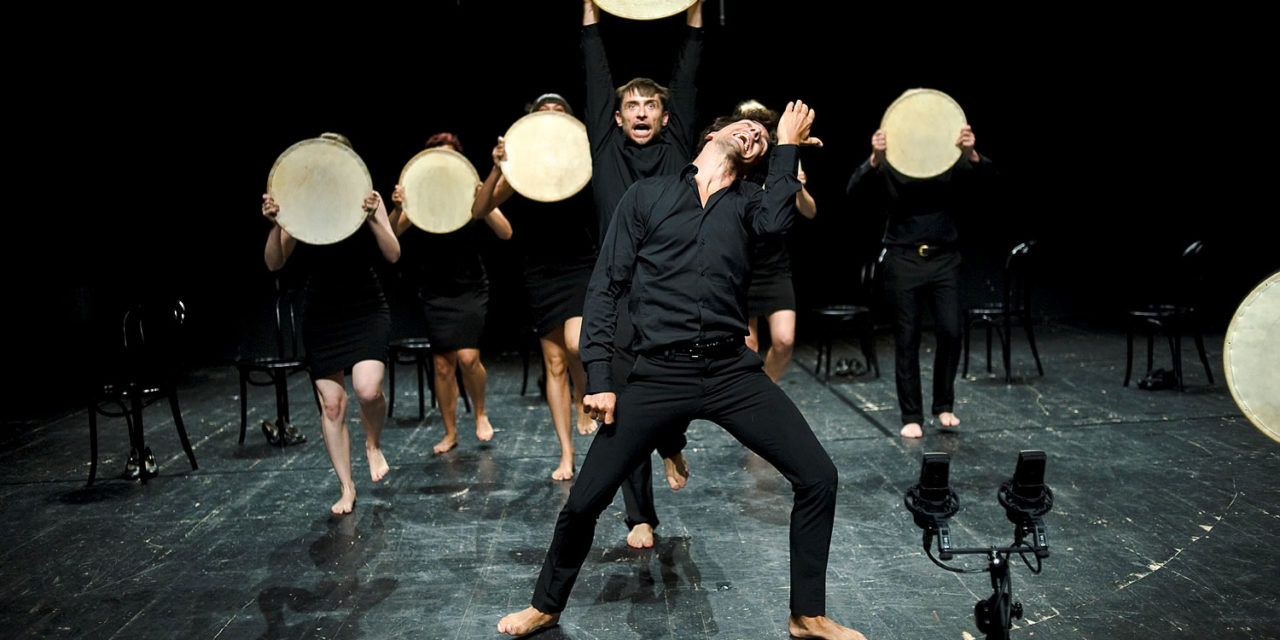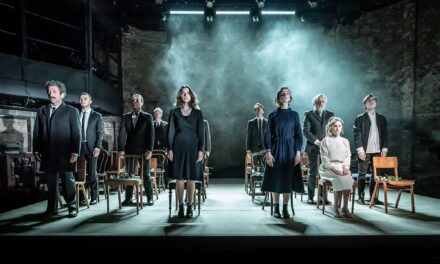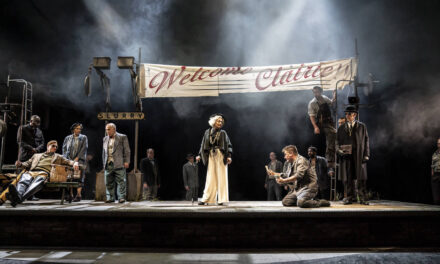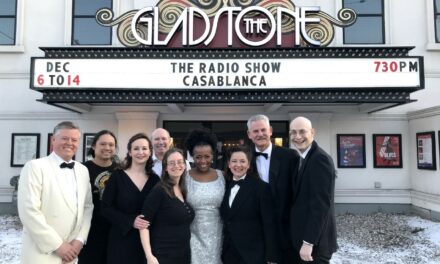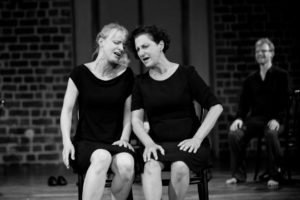
Monika Dryl and Anna Zubrzycki in the final ‘Song of Lear’
Photo Credit: Karol Jarek
Report From Wrocław’s Grotowski Institute (the second annual Summer Seminars) and Teatr Pieśń Kozła (the Polish premiere of Songs of Lear).
Late September in Wrocław. The old tree in the courtyard of the White Stork Synagogue still has its leaves, but they are turning brown. I’m back in town for the second year of the Summer Seminars, a series of English-language lectures on performance organized by the Open University of Research of the Grotowski Institute. O.U.R. director and Jagiellonian University Professor Dariusz Kosiński will be delivering one week of the lectures. His focus this year is the maverick theatre director Jerzy Grotowski (1933-1999) himself.
Grotowski’s “poor theatre” ideology called for performances without unnecessary trappings; in his later work, some of those trappings included the audience and the theatre itself. In the beginning, he reimagined Polish dramas in conjunction with recent history, such as Wyspiański’s Akropolis set in a concentration camp, through almost nothing but the actors’ bodies. His performers were his instruments, and he manipulated them, through rigorous training and prolonged ensemble work, to his – and their – fame. Later in life, Grotowski’s self-proclaimed departure from theatre and his turn towards ritualistic explorations of song and movement only increased his mystique.
For the Seminars, an international group of scholar/practitioners – including some people who met Grotowski in person, and others who only know him from books, or through the work of his followers – gathers daily, over coffee and laptops, in the seminar room of the Institute’s Rynek offices in an attempt to decipher the enigmatic director. Kosiński lectures for five days without seeming to look at his notes. We watch recordings of Grotowski’s three most famous pieces from the early “theatre of productions” phase, before his dramatic exit from the world of drama.
Kosiński emphasizes that all three productions – Akropolis, Constant Prince, and Apocalypsis Cum Figuris – feature extreme physical and vocal precision on the part of the actors. He characterizes the search for precision as central to all Grotowski’s work, and encourages us, rather than accepting the narrative of the turn away from theatre, to see the second and third phases – “paratheatre” and “art as vehicle” – as a continuous evolution of a life’s obsession.
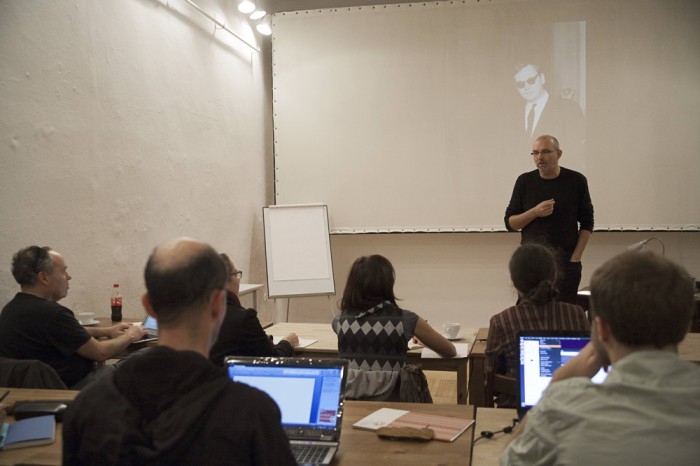
Professor Dariusz Kosiński lecturing Summer Seminars participants with Grotowski on the projection screen behind him Photo Credit: Irena Lipińska
The quest for precision has endured in contemporary Polish theatre, but its manifestations – in or out of the post-Grotowski caravan – are various. After watching the three films, I imagine that it might be possible to characterize individual pieces of Polish theatre as belonging to the family of one of these three iconic spectacles:
Akropolis? Rabelais meets Candide. History and twisted humor.
Constant Prince? Constant pain.
Apocalypsis? Religion, relationships, sexuality, sacrifice.
I’ll get to test this framework soon, on the upcoming Polish premiere of Pieśni Leara (Songs of Lear), by Wrocław’s Teatr Pieśń Kozła (Song of the Goat Theatre). Grzegorz Bral and Anna Zubrzycki worked, before founding their own ensemble, with Theatre Association “Gardzienice’s” Włodzimierz Staniewski, who worked with Grotowski directly.
Later in the week, I visit the converted ul. Purkyniego Wrocław monastery where the Goats work, to interview two company members from very different backgrounds: Rafał Habel and Anu Salonen. Habel grew up in the PRL (People’s Republic of Poland) times, had no formal theatre training, and attended vocational school before venturing into acting. Salonen is a product of Finland’s drama schools and was acting from a young age.
Both Habel and Salonen, after an initial exposure to the Grotowski-esque “co-ordination” ensemble work that Pieśń Kozła uses, found themselves dissatisfied with work at other theatres, and decided to return to Song of the Goat and director Grzegorz Bral. The actors spoke of the necessity they felt to be part of this company, at any cost. The magnetism Kosiński described, which drew performers from across the world to work with Grotowski, and led people to follow him to farmhouses in the Polish countryside, has perhaps endured in some form in the Grotowskian daughter companies.
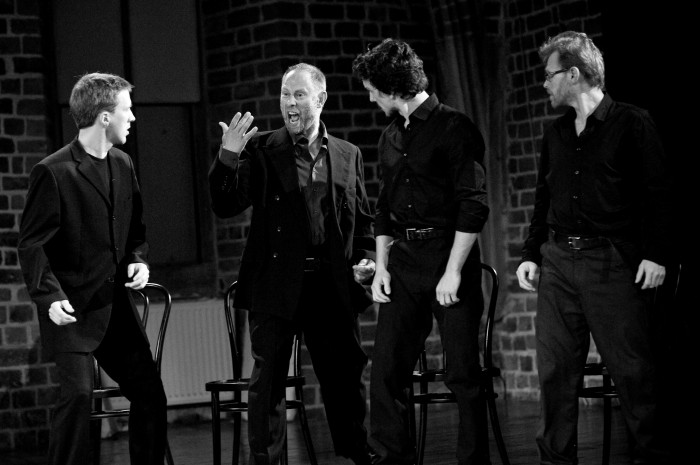
Gabriel Gawin as Lear (facing forward), surrounded by (L to R) Ewan Downie, Paolo Garghentino, and Ian Morgan Song of the Goat Theatre, Photo Credit: Karol Jarek
But maintaining loyalty to the ensemble, even to this seemingly compelling ensemble, is not without difficulties. The Goats are an international group; to rehearse, they have to pull together actors from all over the planet. To make matters more complicated, recently, Bral was also the artistic director of Warsaw’s Teatr Studio, and directing at theatres in cities that were six hours apart by train. Last winter, I saw his Sierpień: Osage County at Studio, as well as a draft version of Pieśni Leara back in Wrocław. Bral seemed to be weathering the super-commute, and exploring his Goat-grown, Grotowski-derived interest in ensemble work within two different stylistic frameworks.
However, due to shake-ups in Polish theatre politics, Bral was summarily ousted from the Studio and replaced by director Tadeusz Słobodzianek. (English-language readers may recognize him as the author of Our Class.) As of 1 October 2012, Słobodzianek has assumed directorship of not only the Studio but also the Dramatyczny, while maintaining his control of Teatr Na Woli. To venture into Warsaw theatre gossip, Słobodzianek’s work is sometimes considered artistically conservative – “safe” – and three big theatres seems too much for any one man, style aside. But it is too soon to say what Słobodzianek’s ascent portends.
One clear result of these shakeups in theatre management is that Grzegorz Bral is now much more consistently in Wrocław with Pieśń Kozła. I try to interview him, but he’s too busy getting ready for the Polish premiere. Company Manager Kasia Maicher is getting lots of calls for seats, fresh off a successful run at the Edinburgh Festival.
While I’m at the monastery, one of the Goats mentions that, before this summer’s Scottish accolades, Bral had been thinking about expanding Pieśni Leara. Now, there is a sense that the piece is, perhaps, complete in concert version, given the excellent audience response. They’ve begun work on a new piece, with material taken from Chekhov. This willingness to respond to audience feedback strikes me as a healthy development in the history of Grotowskian theatre. I’m thinking of an anecdote Kosiński told in the Summer Seminars, about how Grotowski scrapped a completed piece of theatre in between Constant Prince and Apocalypsis Cum Figuris. His audience was eager to see the piece, but that didn’t concern Grotowski; he followed his artistic whim.
One week later, I’m back in Wrocław for the Saturday performance of Pieśni Leara. Bral conducts the seating of the audience, as he will conduct the Songs of Lear themselves. Once we’re sorted, the performers stream in. They are sleek in black suits and dresses, looking like members of an orchestra. They sit on chairs in a semicircle, and Bral introduces the piece. He’ll intersperse almost all the songs that make up Pieśni Leara with spoken commentary, talking about the characters, the sources, the composers. King Lear is a point of departure for their exploration; the text has mostly been fragmented or eliminated, for the needs of the songs.
Pieśni Leara begins with a warm-up on a simple expanding chord. The human accordion of the seated singers flexes. Next, it’s a bouncy piece reminiscent of a medieval madrigal. The precise Anna Zubrzycki intones selections from the Fool’s text on top of it. (When I interviewed Zubrzycki last January, she said that the actors individually composing their own Shakespeare-selected arrangement of texts, choosing the fragments to work with, was part of Pieśń Kozła’s process.) Her technical control, as always, is adamantine; she is clearly audible over the backup chorus even when she makes her voice seem small and squeaky.
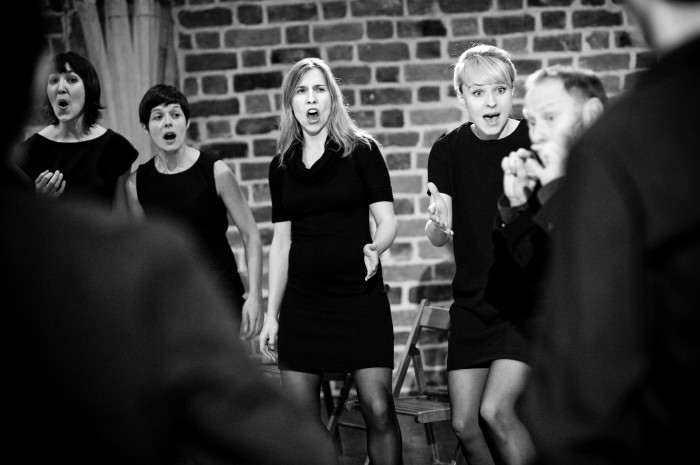
From left to right: Julianna Bloodgood, Rea Mole, Anu Salonen, Monkia Dryl, Gabriel Gawin of The Song of the Goat Theatre, Photo Credit: Karol Jawek
We move into an iconic scene, Cordelia’s expulsion. Lear – Gabriel Gawin, whom we last saw as the title character in TPK’s Macbeth – puts a kind of tarantella-curse on his daughter. She’s played here by Anu Salonen, but represented by other performers at other moments. Salonen stomps her feet involuntarily as if possessed. The relationship between father and daughter seems like that of magician and victim; there is a sensual undercurrent to Salonen’s helplessness.
The next number is, to me, the most original of the piece. Actress Monika Dryl, another Cordelia, sits on a chair with four men surrounding her – pallbearers, jailers. She sings the same song three times in succession: first, from the point of view of Cordelia at 4 years old (breathy, slumped); second, as Cordelia at 11 (louder, more confident); and finally, as the full-blown 17-year-old Cordelia, whose voice is strong but whose heart is completely broken. The changes in age occur with no external aids but her body and voice. Grotowski would have approved.
After this memorable song, my brain was imprinted with Cordelia’s words, as it was with the Fool’s words after Zubrzycki’s song-soliloquy. I enjoyed having “Lo-o-o-ong may you prosper” stuck in my head, and found myself wishing for more similar moments in the piece. I understand that, after the earnest Macbeth, the company is now trying to use source texts in a less literal manner – but if Macbeth had too much text, maybe Pieśni Leara has slightly too little.
After Cordelia is served up 3 ways to her brutal fate, the spektakl accelerates. The performers bang on their chairs. A brace of drumless drumheads are distributed among the company; the company holds the drumheads out for Rafał Habel to take an extended solo. Afterward, we bask in gentle church voices again, but only momentarily. Our blonde Monika Dryl/Cordelia prostrates herself vocally on top of the chorus like a woman throwing herself off a roof.
After this, the actors drone sharply on the warm-up chord we heard at the beginning, and it’s over. There is a sense of relief; Pieśni Leara has enough Constant Prince in it to make it occasionally painful to watch. But I would place this spektakl more in the camp of Apocalypsis. This Lear, and even more so these Cordelias, are sacrificial figures; their pain is meant to redeem the audience.
After touring Mexico with Macbeth in October, the Goats are back in Wrocław this November to sing the Songs of Lear once again. They’ll also give a concert from their Chekhov-based Portraits of Cherry Orchard. Meanwhile, at the Grotowski Institute, the rotation of performances and workshops continues, including monthly O.U.R. lectures – and next fall, another round of English-language Summer Seminars. And Institute resident company Teatr Zar, another third-generation member of the post-Grotowski pack, recently presented a showing of their newest piece, Armine, Sister. Opening, which deals with the Armenian culture and diaspora leading up to the 1915 genocide, as part of November’s VoicEncounters festival.
The last stage of Grotowski’s work, “art as vehicle ”, was restricted to a shrinking number of participants and a minuscule, hand-picked audience. But the acolytes he left behind, and their students, have founded practicing monasteries, based on his work but not limited by it, that are more open to visitors. Nothing but a ticket to Poland prevents you from being one of them.
This article was first published at www.biweekly.pl and reposted with permission. Read the original here.
This post was written by the author in their personal capacity.The opinions expressed in this article are the author’s own and do not reflect the view of The Theatre Times, their staff or collaborators.
This post was written by Dara Weinberg.
The views expressed here belong to the author and do not necessarily reflect our views and opinions.

